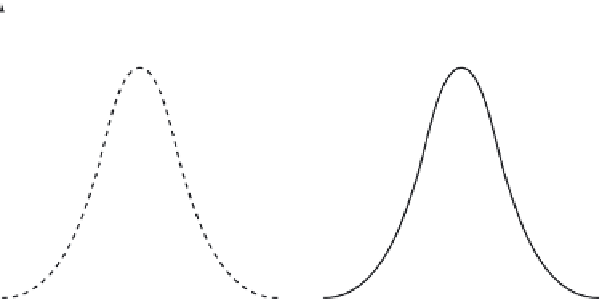Environmental Engineering Reference
In-Depth Information
p
(
c
)
required reduction
∆
distribution required
to meet water-quality
standard
distribution of
measurements
lognormal (
s
log
c
,
m
log
c
)
log
c
std
m
log
c
log
c
b
log
c
Figure 4.20.
Concentration reduction for given flow condition.
compliance with the water-quality standard under all
flow conditions for it not to be impaired, and so this
procedure must be applied to all flow conditions where
water-quality violations occur.
A limitation of the procedure described here is that
it neglects the uncertainty in estimating the
β
-percentile
of the observations, and so applying the Δ reduction to
the observed concentrations has a 50% likelihood of
successfully meeting the water-quality standard. If more
certainty in meeting the water-quality standard is
required, then a more sophisticated method, such as that
given by Chin (2009a), can be used.
c
90,std
= 400 CFU/dL. The minimum required reduction
to meet each regulatory standard will be considered
separately.
Fifty-Percentile Standard.
The 50-percentile con-
centration of the measurements is
c
µ
log
=
10
=
c
50
10
. Since this exceeds the 50-
percentile standard (200 CFU/dL), the stream is
impaired relative to the geometric mean (= 50-
percentile) standard. In accordance with Equation
(4.167), the required reduction, Δ, is given by
2 48
.
=
302
CFU/dL
∆ =
log
(
c
)
−
log
(
c
std
)
=
2.482
−
log
(200)
=
0.181
10
50
10
50,
10
and hence the reduction factor is 10
−Δ
= 10
−0.181
= 0.659.
This is equivalent to a (1 − 0.659) × 100 = 34.1%
reduction in the FC load during moist conditions.
Ninety-Percentile Standard.
The 90-percentile concen-
tration of the observations,
c
90
, is given by
EXAMPLE 4.26
violations of the FC water-quality standard in a particu-
lar stream are found to occur mostly under “moist
conditions,” and instream measurements of FC concen-
trations under this condition are found to be adequately
described by a lognormal distribution. The mean and
standard deviation of the logarithm (to base 10) of the
FC data are 2.482 and 0.342, respectively, when the FC
concentrations are expressed in CFU/dL. Local water-
quality regulations require that FC concentration levels
have a geometric mean concentration less than or equal
to 200 CFU/dL and a 90-percentile concentration less
than or equal to 400 CFU/dL. Determine the required
FC load reduction under moist conditions for both
water-quality standards to be met.
log
c
=
µ
+
z
σ
(4.169)
10
90
log
c
90
log
c
where
z
90
= 1.282 is the 90-percentile standard normal
deviate. Substituting the statistics of the FC measure-
ments into Equation (4.169) gives
log
10
c
=
2.482 (1.282)(0.342)
+
=
2.920
90
which corresponds to a 90-percentile value of
10
2.920
= 832 CFU/dL. Since this exceeds the regula-
tory 90-percentile value (400 CFU/dL), the stream is
impaired relative to the 90-percentile standard. In
accordance with Equation (4.167), the required
reduction, Δ, is given by
Solution
∆ =
log
(
c
)
−
log
(
c
)
=
2.920
−
log
(400)
=
0.318
10
90
10
90,
std
10
From the given data:
µ
logc
= 2.482 and
σ
logc
= 0.342. For
lognormal distributions, the geometric mean is equal to
the 50-percentile concentration, and so the regulatory
limits can be expressed as
c
50,std
= 200 CFU/dL and
and hence the reduction factor is 10
−Δ
= 10
−0.318
= 0.481.
This is equivalent to a (1 − 0.481) × 100 = 51.9%
reduction in the FC load during moist conditions.













Search WWH ::

Custom Search